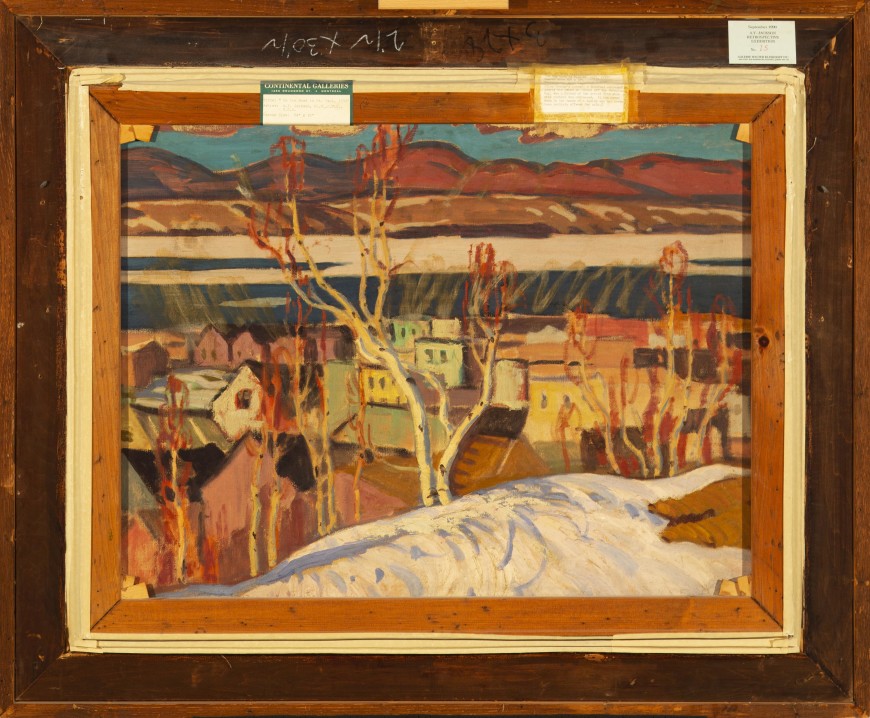-
Œuvres d'art
A.Y. JacksonEarly Spring, Quebec, 19261882-1974Oil on canvas24 x 32 in
61 x 81.3 cmSoldInscriptions
signed, ‘A Y JACKSON’ (recto, lower left)Provenance
Frank Erichsen Brown, Toronto;
Gwethalyn Graham, Montreal.
Continental Galleries, Montreal.
The Collection of Mitzi and Mel Dobrin.
Expositions
Rochester, Memorial Art Gallery, Paintings by Contemporary Canadian Artists, 30 January – 27 February 1927 (also shown at the Toledo Museum of Art, 6-27 March 1927 and Syracuse Museum of Fine Arts, 10 April – 8 May 1927), no. 16 as Early Spring, Quebec.
Saskatoon, Nutana Collegiate, Group of Seven, April 1928, no. 46 as Early Spring, Quebec.
Vancouver, Pacific Exhibition, 12 August 1928, no cat. no. as Early Spring at $300.
Edmonton Museum of Art, 29 October – 3 November 1928, Loan Exhibition, no. 22 as Early Spring.
Galerie Walter Klinkhoff Inc., Montreal, A.Y. Jackson Retrospective Exhibition, September 10 - 22 September 1990, hors catalogue.Documentation
“Exhibitions at Art Gallery Canadian Artists are Foremost in Gallery’s February Exhibition Group of Seven, Represented by Examples of Rare Interest,” Rochester Democrat and Chronicle 13 Feb. 1927, reproduced, as by Arthur LismerIn February and March 1926 A.Y. Jackson painted at La Malbaie with Edwin Holgate and wrote to Marius Barbeau on 25 February, “Holgate & I came down here yesterday all prepared for winter sketching with large supplies of Flake White. Unfortunately there is no snow, in many places the fields are bare. There is hardly six inches anywhere.” And on 4 March Jackson wrote to Thoreau MacDonald “We had a foot of snow the other day. Hard town to paint as in a narrow valley. Bungalows are mixed in with the older houses and bungalows will be hopeless even after they are a million years old, even covered the pile of snow would be ugly.” The two artists walked nine miles to the village of Saint Fidèle which delighted Jackson and then returned to La Malbaie where Albert Robinson joined them.
On his return to Toronto Jackson painted an initial composition depicting the river and houses of La Malbaie viewed from a rise above the village. Clearly dissatisfied with the way it was going, Jackson rejected the “dud” and used the other side of the canvas to paint farms and houses aligned along a country road. The lovely pink house and leaning tree in the foreground frame the barns and sheds and the yellow and white houses on the left. The muddy road, still surrounded by the receding snow, is highlighted with pools of blue water. In the distance a wayside cross overlooks the distant white and pink houses. The rolling hillock in the background crowns the composition curiously recalling the landscape around Saint-Urbain that Jackson painted frequently in the early thirties. Pink, blue and white clouds skitter across the clear, blue sky.
The compositional device of a road leading from the foreground into the landscape is seen frequently in J.W. Morrice’s Quebec canvases of the 1890s and Jackson would use it again in his 1926 canvas Winter, Quebec (National Gallery of Canada) and more boldly in his 1927 canvas, also titled Early Spring, Quebec, in the Art Gallery of Ontario.
Jackson’s Early Spring, Quebec was included in the exhibition Paintings by Contemporary Canadian Artists organized by the Director of the Albright Gallery in Buffalo, William Hekking, who had selected the Canadian paintings for the Sesqui-Centennial Exhibition in Philadelphia in 1926. The painting was subsequently chosen by the artists to tour in western Canada.
According to a label on the back of the stretcher, this painting was acquired by Gwethalyn Graham, the author of the novel Earth and High Heaven that exposed the anti-Semitism found among some Anglo-Montrealers during the war. That book won the Governor General’s Prize for Fiction in 1944. Graham was the daughter of Isabel and Frank Erichsen Brown, a native of Galt, Ontario, and a prominent Toronto lawyer and amateur artist. In the 1930s Jackson was a regular guest of the Browns at their cottage on Georgian Bay. In his correspondence Jackson referred to Isabel Brown as a cousin and, as he wrote in his autobiography, A Painter’s Country, Jackson later discovered that his grandfather and Frank Brown’s grandmother were brother and sister.
Charles C. Hill1sur 7










